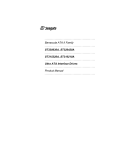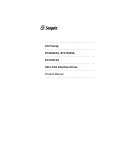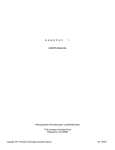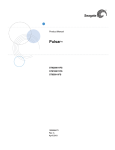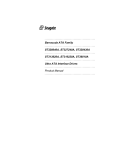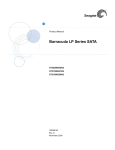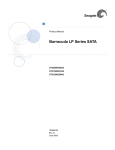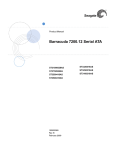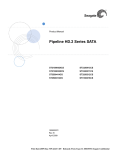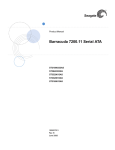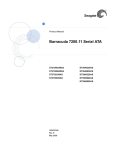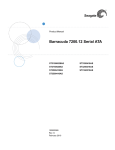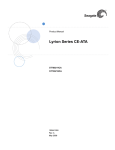Download Seagate ST1.2 - Series 8 GB Removable Hard Drive Product manual
Transcript
Product Manual ST1.3 Series ST612712DEG ST680712DEG ST612712DE ST680712DE ST610712DEG ST660712DEG ST610712DE ST660712DE 100409345 Rev. D September 2007 Copyright © 2006 - 2007 Seagate Technology LLC. All rights reserved. Printed in U.S.A. Publication number: 100409345, Rev. D September 2007 Seagate, Seagate Technology and the Wave logo are registered trademarks of Seagate Technology LLC in the United States and/or other countries. ST1.3 Series, SeaTools and SeaTDD are either trademarks or registered trademarks of Seagate Technology LLC or one of its affiliated companies in the United States and/or other countries. All other trademarks or registered trademarks are the property of their respective owners. One gigabyte, or GB, equals one billion bytes when referring to hard drive capacity. Accessible capacity may vary depending on operating environment and formatting. Quantitative usage examples for various applications are for illustrative purposes. Actual quantities will vary based on various factors, including file size, file format, features and application software. Seagate reserves the right to change, without notice, product offerings or specifications. Contents 1.0 Introduction. . . . . . . . . . . . . . . . . . . . . . . . . . . . . . . . . . . . . . . . . . . . . . . . . . . . . . . . . . . . . . . . . . . 1.1 Disclaimer . . . . . . . . . . . . . . . . . . . . . . . . . . . . . . . . . . . . . . . . . . . . . . . . . . . . . . . . . . . . . . 1.2 Drive care . . . . . . . . . . . . . . . . . . . . . . . . . . . . . . . . . . . . . . . . . . . . . . . . . . . . . . . . . . . . . . 1.3 Handling precautions . . . . . . . . . . . . . . . . . . . . . . . . . . . . . . . . . . . . . . . . . . . . . . . . . . . . . . 2.0 Drive specifications . . . . . . . . . . . . . . . . . . . . . . . . . . . . . . . . . . . . . . . . . . . . . . . . . . . . . . . . . . . . 3 2.1 Power, access times and acoustics. . . . . . . . . . . . . . . . . . . . . . . . . . . . . . . . . . . . . . . . . . . 3 2.2 Formatted capacity . . . . . . . . . . . . . . . . . . . . . . . . . . . . . . . . . . . . . . . . . . . . . . . . . . . . . . . 5 2.3 Default logical geometry . . . . . . . . . . . . . . . . . . . . . . . . . . . . . . . . . . . . . . . . . . . . . . . . . . . 5 2.4 Recording and interface technology . . . . . . . . . . . . . . . . . . . . . . . . . . . . . . . . . . . . . . . . . . 6 2.5 Physical characteristics . . . . . . . . . . . . . . . . . . . . . . . . . . . . . . . . . . . . . . . . . . . . . . . . . . . 6 2.6 Time to ready. . . . . . . . . . . . . . . . . . . . . . . . . . . . . . . . . . . . . . . . . . . . . . . . . . . . . . . . . . . . 6 2.7 Power specifications . . . . . . . . . . . . . . . . . . . . . . . . . . . . . . . . . . . . . . . . . . . . . . . . . . . . . . 7 2.7.1 Power consumption . . . . . . . . . . . . . . . . . . . . . . . . . . . . . . . . . . . . . . . . . . . . . . . 7 2.7.2 Conducted noise . . . . . . . . . . . . . . . . . . . . . . . . . . . . . . . . . . . . . . . . . . . . . . . . . 9 2.7.3 Voltage tolerance . . . . . . . . . . . . . . . . . . . . . . . . . . . . . . . . . . . . . . . . . . . . . . . . . 9 2.7.4 Power-management modes . . . . . . . . . . . . . . . . . . . . . . . . . . . . . . . . . . . . . . . . 10 2.8 Environmental specifications . . . . . . . . . . . . . . . . . . . . . . . . . . . . . . . . . . . . . . . . . . . . . . . 11 2.8.1 Ambient temperature . . . . . . . . . . . . . . . . . . . . . . . . . . . . . . . . . . . . . . . . . . . . . 11 2.8.2 Temperature gradient. . . . . . . . . . . . . . . . . . . . . . . . . . . . . . . . . . . . . . . . . . . . . 11 2.8.3 Humidity . . . . . . . . . . . . . . . . . . . . . . . . . . . . . . . . . . . . . . . . . . . . . . . . . . . . . . . 11 2.8.4 Altitude . . . . . . . . . . . . . . . . . . . . . . . . . . . . . . . . . . . . . . . . . . . . . . . . . . . . . . . . 11 2.8.5 Shock . . . . . . . . . . . . . . . . . . . . . . . . . . . . . . . . . . . . . . . . . . . . . . . . . . . . . . . . . 12 2.8.6 Vibration . . . . . . . . . . . . . . . . . . . . . . . . . . . . . . . . . . . . . . . . . . . . . . . . . . . . . . . 12 2.9 Acoustics . . . . . . . . . . . . . . . . . . . . . . . . . . . . . . . . . . . . . . . . . . . . . . . . . . . . . . . . . . . . . . 15 2.10 Electromagnetic immunity . . . . . . . . . . . . . . . . . . . . . . . . . . . . . . . . . . . . . . . . . . . . . . . . . 15 2.11 Reliability . . . . . . . . . . . . . . . . . . . . . . . . . . . . . . . . . . . . . . . . . . . . . . . . . . . . . . . . . . . . . . 16 2.12 Agency certification . . . . . . . . . . . . . . . . . . . . . . . . . . . . . . . . . . . . . . . . . . . . . . . . . . . . . . 17 2.12.1 Safety certification . . . . . . . . . . . . . . . . . . . . . . . . . . . . . . . . . . . . . . . . . . . . . . . 17 2.12.2 Electromagnetic compatibility. . . . . . . . . . . . . . . . . . . . . . . . . . . . . . . . . . . . . . . 17 2.12.3 European Union Restriction of Hazardous Substances (RoHS) Directive . . . . . 17 2.12.4 China Restriction of Hazardous Substances (RoHS) Directive . . . . . . . . . . . . . 18 2.12.5 FCC verification . . . . . . . . . . . . . . . . . . . . . . . . . . . . . . . . . . . . . . . . . . . . . . . . . 18 3.0 Configuring and mounting the drive . . . . . . . . . . . . . . . . . . . . . . . . . . . . . . . . . . . . . . . . . . . . . 3.1 Handling and static discharge precautions . . . . . . . . . . . . . . . . . . . . . . . . . . . . . . . . . . . . 3.2 Drive installation . . . . . . . . . . . . . . . . . . . . . . . . . . . . . . . . . . . . . . . . . . . . . . . . . . . . . . . . 3.3 Mounting considerations . . . . . . . . . . . . . . . . . . . . . . . . . . . . . . . . . . . . . . . . . . . . . . . . . . 21 21 22 24 4.0 Interface description . . . . . . . . . . . . . . . . . . . . . . . . . . . . . . . . . . . . . . . . . . . . . . . . . . . . . . . . . . 4.1 Connector interface signals and connector pins . . . . . . . . . . . . . . . . . . . . . . . . . . . . . . . . 4.1.1 Supported ATA commands . . . . . . . . . . . . . . . . . . . . . . . . . . . . . . . . . . . . . . . . 4.1.2 Identify Device command. . . . . . . . . . . . . . . . . . . . . . . . . . . . . . . . . . . . . . . . . . 4.1.3 Set Features command . . . . . . . . . . . . . . . . . . . . . . . . . . . . . . . . . . . . . . . . . . . 25 25 27 28 31 5.0 Seagate Technology support services . . . . . . . . . . . . . . . . . . . . . . . . . . . . . . . . . . . . . . . . . . . . 33 ST1.3 Series Product Manual, Rev. D 1 2 2 2 i ii ST1.3 Series Product Manual, Rev. D List of Figures Figure 1. Figure 2. Figure 3. Figure 4. Figure 5. Figure 6. Figure 7. Figure 8. Figure 9. Figure 10. Figure 11. Figure 12. ST1.3 Series IDE interface (ZIF connector) disc drive . . . . . . . . . . . . . . . . . . . . . . . . . . . . . . . 1 ST1.3 Series breather hole location . . . . . . . . . . . . . . . . . . . . . . . . . . . . . . . . . . . . . . . . . . . . . 2 ST1.3 Series improper handling example. . . . . . . . . . . . . . . . . . . . . . . . . . . . . . . . . . . . . . . . . 2 Typical 3.3V startup and operation current profile . . . . . . . . . . . . . . . . . . . . . . . . . . . . . . . . . . 8 Location where tri-axial accelerometer will be placed on ST1.3 Series drives . . . . . . . . . . . . 12 Drive axis definition for ST1.3 Series drives . . . . . . . . . . . . . . . . . . . . . . . . . . . . . . . . . . . . . . 12 ST1.3 Series proper handling example . . . . . . . . . . . . . . . . . . . . . . . . . . . . . . . . . . . . . . . . . 21 ST1.3 Series improper handling example. . . . . . . . . . . . . . . . . . . . . . . . . . . . . . . . . . . . . . . . 22 ST1.3 Series mechanical dimensions—top, bottom, side and end view . . . . . . . . . . . . . . . . 23 ST1.3 Series Area for Protective Mounting . . . . . . . . . . . . . . . . . . . . . . . . . . . . . . . . . . . . . . 24 ST1.3 Series Mounting Drive using FPC with Multiple Bends . . . . . . . . . . . . . . . . . . . . . . . . 24 ST1.3 Series ZIF connector with Groove for FPC with Tab . . . . . . . . . . . . . . . . . . . . . . . . . . 24 ST1.3 Series Product Manual, Rev. D iii iv ST1.3 Series Product Manual, Rev. D 1.0 Introduction This manual describes the functional, mechanical and interface specifications for the following Seagate® ST1.3 Series drives: • ST612712DE-12GB, ST610712DE-10GB, ST680712DE-8GB and ST660712DE-6GB disc drives with a ZIF (zero insertion force) connector using an IDE interface. • ST612712DEG-12GB, ST610712DEG-10GB, ST680712DEG-8GB and ST660712DEG-6GB disc drives with a ZIF (zero insertion force) connector using an IDE interface. These models incorporate an additional free-fall sensor for robust drop performance. These drives provide the following key features. • 3,600-RPM spindle speed and a 2-Mbyte buffer combined for superior read/write performance. • Quiet operation. Fluid Dynamic Bearing (FDB) motor. • Tunneling Magnetoresistive (TMR) recording heads provide the drives with increased areal density. • State-of-the-art cache and on-the-fly error-correction algorithms. • 2.0K Gs nonoperating shock, and 300 Gs operating shock. • SeaTools™ diagnostic software performs a drive self-test that eliminates unnecessary drive returns. Figure 1. ST1.3 Series IDE interface (ZIF connector) disc drive ST1.3 Series Product Manual, Rev. D 1 1.1 Disclaimer Seagate Technology LLC makes no warranties whatsoever, including any warranty of merchantability, noninfringement, fitness for any particular purpose, or any warranty otherwise arising out of any proposal, specification or sample. Seagate may not be held liable for any direct, indirect, incidental, special, exemplary, or consequential damages (including, but not limited to, loss of use, data, or profits; procurement of substitute goods or services; or business interruptions) however caused and on any theory of liability, whether in contract, strict liability, or tort (including negligence or otherwise) arising in any way from the use of this kit, even if advised of the possibility of such damage. 1.2 Drive care Do not use the ST1.3 Series disc drives outside of the ranges of environmental conditions found in Section 2.8, "Environmental specifications." Doing so may void the warranty of the ST1.3 Series disc drive. 1.3 Handling precautions • Do not cover or seal the breather hole! Covering or sealing the breather hole may result in loss of data. Figure 2. ST1.3 Series breather hole location • Do not apply any force to the drive during handling or installation. • When handling the drive, wear an wrist strap that is properly grounded to prevent damage from electrostatic discharge (ESD). • Handle the drive carefully by the edges. Do not touch any exposed printed circuit board or the top cover. • The drive is fragile—handle it with care. Do not press down on the top cover or attempt to use a pen to write on the drive’s label. Do not apply more than 0.2 kg of force to the top cover. Figure 3. ST1.3 Series improper handling example • Do not drop the drive. • Do not expose the drive to wet conditions. • Do not place the drive near a strong magnetic field. • Do not expose the drive to extreme temperatures. • The drive may become hot during operation. Be careful when removing the drive from the host device immediately after operation. 2 ST1.3 Series Product Manual, Rev. D 2.0 Drive specifications Unless otherwise noted, all specifications are measured under ambient conditions, at 25°C, and nominal power. For convenience, the phrases the drive and this drive are used throughout this manual to indicate ST612712DE, ST612712DEG, ST610712DE, ST610712DEG, ST680712DE, ST680712DEG, ST660712DE and ST660712DEG model drives. 2.1 Power, access times and acoustics The specifications listed in this table are for quick reference. For details on specification measurement or definition, see the appropriate section of this manual. Table 1: Specifications Drive specification ST612712DEG ST610712DEG ST680712DEG ST660712DEG ST612712DE ST610712DE ST680712DE ST660712DE Formatted Gbytes 12.0 10.0 8.0 6.0 Guaranteed sectors 23,438,016 19,533,024 15,625,008 11,719,008 Physical heads 2/1 Physical discs 1 Bytes per sector (logical) 512 Cache (Mbytes) 2 Recording density, BPI (bits/inch max) 933,000 Track density. TPI (tracks/inch max) 140,000 Areal density (Gbits/inch2 max) 130.6 Spindle speed (RPM) 3,600 Internal data transfer rate OD (Mbits/sec max) 130.0 Sustained data transfer rate OD (Mbytes/sec) 10.2 I/O data-transfer rate (Mbytes/sec max) 66.7 (UDMA 4) ATA data-transfer modes supported PIO modes 0–4; Multiword DMA modes 0-2; Ultra DMA modes 0–4 Height (max) 5.1 mm (0.2009 inches) Width 40.0 +/-0.2 mm (1.5748 +/-0.008 inches) Length 30.0 +/-0.2 mm (1.1811 +/-0.008 inches) Weight 13.6 gm - 0.3000 lb. (typ) Average latency (msec) 8.3 Power-on to ready (sec typical / max) (without retry) 1.0 / 2.5 Standby to ready (sec typical / max) (without retry) 1.0 / 2.5 Startup current 3.3v (peak) (maximum RMS in 10ms window) 330 mA Seek power (typical 3.3V) 154 mA ST1.3 Series Product Manual, Rev. D 3 Table 1: Specifications Drive specification ST612712DEG ST610712DEG ST680712DEG ST660712DEG ST612712DE ST610712DE ST680712DE ST660712DE Read/write power (typical 3.3V) 230/240 mA Performance idle mode (typical 3.3V) 140 mA Low power idle mode (typical 3.3V) 77 mA Standby/Sleep mode (typical 3.3V) 13 mA Voltage tolerance (including noise) 3.3V ± 5% Ambient temperature 0° to 60°C (operating) –40° to 70°C (nonoperating) Temperature gradient (°C per hour max) 20°C (operating) 30°C (nonoperating) Relative humidity (noncondensing) 5% to 90% (operating) 5% to 95% (nonoperating) Relative humidity gradient 30% per hour max Wet bulb temperature (°C max) 33°C (operating) 40°C (nonoperating) Altitude, operating –60.98 m to 3,048 m (–200 ft to 10,000+ ft) Altitude, nonoperating (below mean sea level, max) –60.98 m to 12,192 m (–200 ft to 40,000+ ft) Shock, operating (Gs max at 1 msec) 300 Shock, nonoperating (Gs max at 1 msec) 2000 Vibration, operating (max displacement may apply below 10 hz) 1.0 Gs (0 to peak, 10–500 Hz) @ 2 oct/min sweep rate Vibration, nonoperating (max displacement may apply below 22 hz) 5.0 Gs (0 to peak, 10–500 Hz) @ 0.5 oct/min sweep rate Drive acoustics, sound power (bels) Idle (typical / max) 1.6/ 1.9 Operational (typical / max) 1.7 / 2.0 Nonrecoverable read errors 1 per 1014 bits read Load/Unload (LUL) cycles (25°C) 300,000 software-controlled power on/off cycles 20,000 hard power on/off cycles Warranty Per agreement 4 ST1.3 Series Product Manual, Rev. D 2.2 Model Formatted capacity Formatted capacity Guaranteed sectors Bytes per sector ST612712DEG 12.0 Gbytes ST612712DE 23,438,016 512 ST610712DEG 10.0 Gbytes ST610712DE 19,533,924 512 ST680712DEG 8.0 Gbytes ST680712DE 15,625,008 512 ST660712DEG 6.0 Gbytes ST660712DE 11,719,008 512 2.3 Model Default logical geometry Cylinders Read/write heads Sectors per track ST612712DEG ST612712DE ST610712DEG ST610712DE 16,383 ST680712DEG ST680712DE ST660712DEG ST660712DE 16 63 LBA mode When addressing these drives in LBA mode, all blocks (sectors) are consecutively numbered from 0 to n–1, where n is the number of guaranteed sectors as defined above. ST1.3 Series Product Manual, Rev. D 5 2.4 Recording and interface technology Technology Specification Interface Seagate (ZIF) Flex Connector (35-way) Recording method Perpendicular Magnetic Recording Recording density BPI (bits/inch max) 933,000 Track density TPI (tracks/inch max) 140,000 Areal density (Gbits/inch2 max) 130.6 Spindle speed (RPM) (± 0.2%) 3,600 Internal data-transfer rate OD (Mbits/sec max) 130.0 Sustained data transfer rate OD (Mbytes/sec max) 10.2 I/O data-transfer rate (Mbytes/sec max) 66.7 (UDMA 4) Interleave 1:1 Cache buffer All models 2.5 2 Mbytes (2,048 Kbytes) Physical characteristics Height (mm) (inches) 5.1 (max) 0.2007 (max) Width (mm) (inches) 40.0 +/-0.2 1.5748 +/-0.008 Length (mm) (inches) 30.0 +/-0.2 1.1811 +/-0.008 Typical weight (grams) (pounds) 13.6 (typ) 0.030 (typ) Interface Connector 2.6 Seagate (ZIF) Flex Connector (35-way) Time to ready Time to ready Typical Max (without retry) Power-On to Ready (sec) 1.0 2.5 Standby to Ready (sec) 1.0 2.5 6 ST1.3 Series Product Manual, Rev. D 2.7 Power specifications The drive receives DC power (+3.3V) through the ZIF (IDE interface) connector for ST612712DE, ST612712DEG, ST610712DE, ST610712DEG, ST680712DEG, ST680712DE, ST660712DEG and ST660712DE models. 2.7.1 Power consumption Power requirements for the drives are listed in the table on page 8. Typical power measurements are based on an average of drives tested, under nominal conditions, using +3.3V input voltage at 25°C ambient temperature. • Spinup power Spinup power is measured from the time of power-on to the time that the drive spindle reaches operating speed. • Seek mode During seek mode, the read/write actuator arm moves toward a specific position on the disc surface and does not execute a read or write operation. Servo electronics are active. Seek mode power is measured based on three random seek operations every 100 msecs. This mode is not typical. • Read/write power and current Read/write power is measured with the heads on track, at the moment while the head is writing/reading from/to disc. It is performed with 100 percent duty cycle of write/read operation. • Low power idle mode Spindle motor is working normally with actuator unloaded to the parked position. • Standby mode / Sleep mode During Standby mode, the drive accepts commands, but the drive is not spinning, and the servo and read/ write electronics are in power-down mode. ST1.3 Series Product Manual, Rev. D 7 Table 2: DC power ST1.3 Series Power Consumption (W) Max current the average of the peak value in 10ms window Average 3.3V (mA) Max 3.3V (mA) Current 270 330 Spinup 180 300 Load/Unload current 190 200 Write 240 300 Read 230 300 Seek 154 161 Performance idle 140 147 Low power idle 77 86 Standby/Sleep 13 18 *During periods of drive idle, some offline activity may occur according to the S.M.A.R.T. specification, which may increase acoustic and power to operational levels. 2.7.1.1 Typical current profile Figure 4. Typical 3.3V startup and operation current profile 8 ST1.3 Series Product Manual, Rev. D 2.7.2 Conducted noise Input noise ripple is measured at the host system power supply across an equivalent 15-ohm resistive load on the +3.3 volt line. Using 3.3-volt power, the drive is expected to operate with a maximum of 70 mV peak-to-peak square-wave injected noise at up to 20 MHz. Note. Equivalent resistance is calculated by dividing the nominal voltage by the typical RMS read/write current. 2.7.3 Voltage tolerance Voltage tolerance (including noise): 3.3V ± 5% ST1.3 Series Product Manual, Rev. D 9 2.7.4 Power-management modes The drive provides programmable power management to provide greater energy efficiency. The drive features the following power-management modes: Table 3: Power-management modes Power modes Heads Spindle Buffer Active (operating) Tracking Rotating Enabled Idle, performance Tracking Rotating Enabled Idle, low power Parked Stopped Disabled Standby/Sleep Parked Stopped Disabled • Active mode The drive is in Active mode during the read/write and seek operations. • Low power idle mode Drive enters Low Power Idle mode from Performance Idle mode when the Advanced Power Management Level is set between FDh and 80h, and the Idle timer is reached at 2 seconds (default setting is 2 seconds). Disc is not spinning and heads are parked and drive accepts all commands and returns to Active mode any time disc access is necessary. • Performance idle mode The buffer remains enabled, and the drive accepts all commands and returns to Active mode any time disc access is necessary. • Standby/Sleep mode The drive enters Standby mode when the host sends a Standby Immediate command. If the host has set the standby timer, the drive can also enter Standby mode automatically after the drive has been inactive for a specifiable length of time. The standby timer delay is established using a Standby or Idle command. In Standby mode, the drive buffer is disabled, the heads are parked and the spindle is at rest. The drive accepts all commands and returns to Active mode any time disc access is necessary. • Standby timers Each time the drive performs an Active function (such as read, write or seek), the standby timer is reinitialized and begins counting down from its specified delay times to zero. If the standby timer reaches zero before any drive activity is required, the drive makes a transition to Standby mode. In both Idle and Standby mode, the drive accepts all commands and returns to Active mode when disc access is necessary. 10 ST1.3 Series Product Manual, Rev. D 2.8 Environmental specifications 2.8.1 Ambient temperature Ambient temperature is defined as the temperature of the environment immediately surrounding the drive. Actual drive case temperature should not exceed 70°C (158°F) within the operating ambient conditions. Case temperature of the drive operating at 60°C ambient may hit a maximum of 70°C at certain parts of the casing. Above 1,000 feet (305 meters), the maximum temperature is derated linearly by 1°C every 1000 feet. Operating Nonoperating 2.8.2 0° to 60°C (32° to 140°F) (70°C max case temperature) –40° to 70°C (–40° to 158°F) Temperature gradient Operating 20°C per hour (36°F per hour max), without condensation Nonoperating 30°C per hour (54°F per hour max), without condensation 2.8.3 Humidity 2.8.3.1 Relative humidity Operating 5% to 90% noncondensing (30% per hour max) Nonoperating 5% to 95% noncondensing (30% per hour max) 2.8.3.2 Wet bulb temperature Operating 33°C (91.4°F max) [1] Nonoperating 40°C (104°F max) [2] [1] [2] Operating: Wet bulb temperature is calculated by the operating Temperature and the Relative Humidity levels. Nonoperating: Wet bulb temperature is calculated by the nonoperating Temperature and the Relative Humidity levels. 2.8.4 Altitude Operating Nonoperating –60.98 m to 3,048 m (–200 ft to 10,000+ ft) –60.98 to 12,192 m (–200 ft to 40,000+ ft) ST1.3 Series Product Manual, Rev. D 11 2.8.5 Shock All shock measurements in this section are carried out at drive level. For all linear shock test, operating or nonoperating, the input shock level shall be measured at the frame of the disk drive at the specific location indicated by the ellipse in Figure 5 below for the ZIF interface drives. Figure 5. Location where tri-axial accelerometer will be placed on ST1.3 Series drives All shock test will cover all the 6 directions, +/- x, y and z axes. The drive axis definition in shown in Figure 6 below. Figure 6. Drive axis definition for ST1.3 Series drives 2.8.5.1 Operating shock The drive will be subjected to 10 shocks for each direction. During the shocks, there must be a minimum delay of 3 seconds between shock pulses. Soft errors and automatic retries are allowed during the test. No data loss or permanent damage occurs during a half sine shock pulse of: 300 Gs, 1 msec 2.8.5.2 Nonoperating shock The nonoperating shock level that the drive can experience without incurring any physical damage when subsequently put into operation is 2000 Gs. The same applies for shock levels of 2000 Gs, 1 msec pulse duration on fresh drives for each level. 2.8.6 Vibration All vibration specifications assume that the drive is mounted securely in a fixture that does not have fixture resonances in the frequency test range. 12 ST1.3 Series Product Manual, Rev. D 2.8.6.1 Operating sweep sine vibration The following lists the maximum operating sweep sine vibration levels that the drive may experience while meeting the performance standards specified. It will consist of a forward and backward sweep from 10 Hz to 500 Hz to 10 Hz. The drive will operate without a hard error while being subjected to the following vibration levels. 10 Hz to 500 Hz @ 2 oct/min 2.8.6.2 1.0 Gs (0 to pk). Maximum displacement may apply below 10 Hz. Operating random vibration The test consists of 30 minutes of random vibration using the power spectral density (PSD) levels specified in the table below. The vibration test level is 0.67 Gs RMS. The drive will operate without a hard error while being subjected to the following vibration levels. Table 4: 2.8.6.3 Operating random vibration profile Frequency (Hz) G2/Hz 17 1.1 x E-03 45 1.1 x E-03 48 8.0 x E-03 62 8.0 x E-03 65 1.0 x E-03 150 1.0 x E-03 200 5.0 x E-04 500 5.0 x E-04 Nonoperating sweep sine vibration The following table lists the maximum nonoperating sweep sine vibration levels that the drive may experience while meeting the performance standards specified. It will consist of a forward and backward sweep from 5 Hz to 500 Hz to 5 Hz. The drive will not incur any physical damage when subsequently put into operation. 10 Hz to 500 Hz @ 0.5 oct/min 5 Hz to 10 Hz ST1.3 Series Product Manual, Rev. D 5.0 Gs (0 to pk). Maximum displacement may apply below 22 Hz. 25.4 mm peak to peak displacement. 13 2.8.6.4 Nonoperating random vibration The test consists of 15 minutes of random vibration using the power spectral density (PSD) levels specified in the table below. The vibration test level is 3.01 Gs RMS. The drive will not incur any physical damage when subsequently put into operation. Table 5: 2.8.6.5 Nonoperating random vibration profile. Frequency (Hz) G2/Hz 2.5 1.0 x E-03 5 3.0 x E-02 40 1.8 x E-02 500 1.8 x E-02 Corrosive environment Seagate electronic drive components pass accelerated corrosion testing equivalent to ten years of exposure to light industrial environments containing sulfurous gases, chlorine and nitric oxide, classes G and H per ASTM B845. However, this accelerated testing cannot duplicate every potential application environment. Users should use caution exposing any electronic components to uncontrolled chemical pollutants and corrosive chemicals as electronic drive component reliability can be affected by the installation environment. The silver, copper, nickel and gold films used in Seagate products are especially sensitive to the presence of sulfide, chloride, and nitrate contaminants. Sulfur is found to be the most damaging. In addition, electronic components should never be exposed to condensing water on the surface of the printed circuit board assembly (PCBA) or exposed to an ambient relative humidity greater than 95 percent. Materials used in cabinet fabrication, such as vulcanized rubber, that can outgas corrosive compounds should be minimized or eliminated. The useful life of any electronic equipment may be extended by replacing materials near circuitry with sulfide-free alternatives. 14 ST1.3 Series Product Manual, Rev. D 2.9 Acoustics Drive acoustics are measured as overall A-weighted acoustic sound power levels (no pure tones). Discrete tone penalties are added to the A-weighted sound power (LW) with the following formula only when determining compliance: LWt(spec) == LW + 0.1Pt + 0.3 < 4.0 (Bels) where LW = A-weighted sound power level pt == Value of discrete tone penalty [==dLt-6.0 (dBA)] dLt = Tone-to-noise ratio taken in accordance with ISO 7779. All measurements are consistent with ISO document 7779. Sound power measurements are taken under essentially free-field conditions over a reflecting plane. For all tests, the drive is oriented with the cover facing upward. Note. For seek mode tests, the drive is placed in seek mode only. The number of seeks per second is defined by the following equation: (Number of seeks per second = 0.4 / (average latency + average access time) Table 6: Drive level acoustics Acoustic mode Idle Operational 1.6 bels (typ) 1.7 bels (max) 1.9 bels (typ) 2.0 bels (max) 2.10 Electromagnetic immunity When properly installed in a representative host system, the drive operates without errors or degradation in performance when subjected to the radio frequency (RF) environments defined in the following table: Table 7: Electromagnetic immunity Performance level Reference standard 80 to 1,000 MHz, 3 V/m, 80% AM with 1 kHz sine 900 MHz, 3 V/m, 50% pulse modulation @ 200 Hz A EN 61000-4-3: 96 ENV 50204: 95 Electrical fast transient ± 1 kV on AC mains, ± 0.5 kV on external I/O B EN 61000-4-4: 95 Surge immunity ± 1 kV differential, ± 2 kV common, AC mains B EN 61000-4-5: 95 Conducted RF immunity 150 kHz to 80 MHz, 3 Vrms, 80% AM with 1 kHz sine A EN 61000-4-6: 97 Voltage dips, interrupts 0% open, 5 seconds 0% short, 5 seconds 40%, 0.10 seconds 70%, 0.01 seconds C C C B EN 61000-4-11: 94 Test Description Radiated RF immunity ST1.3 Series Product Manual, Rev. D 15 2.11 Reliability Measurement type Specification Nonrecoverable read errors 1 per 1014 bits read, max. Load/Unload (LUL) cycles (25°C) 300,000 software-controlled power on/off cycles 20,000 hard power on/off cycles Power On Hours (POH) 500 hours Warranty Per agreement 16 ST1.3 Series Product Manual, Rev. D 2.12 Agency certification 2.12.1 Safety certification The drives are recognized in accordance with UL60950-1, CAN/CSA-C22.2 No.60950-1, EN60950 and IEC 60950. 2.12.2 Electromagnetic compatibility Hard drives that display the CE mark comply with the European Union (EU) requirements specified in the Electromagnetic Compatibility Directive (89/336/EEC). Testing is performed to the levels specified by the product standards for Information Technology Equipment (ITE). Emission levels are defined by EN 55022, Class B and the immunity levels are defined by EN 55024. Seagate uses an independent laboratory to confirm compliance with the EC directives specified in the previous paragraph. Drives are tested in representative end-user systems. Although CE-marked Seagate drives comply with the directives when used in the test systems, we cannot guarantee that all systems will comply with the directives. The drive is designed for operation inside a properly designed enclosure, with properly shielded I/O cable (if necessary) and terminators on all unused I/O ports. Computer manufacturers and system integrators should confirm EMC compliance and provide CE marking for their products. Korean RRL If these drives have the Korea Ministry of Information and Communication (MIC) logo, they comply with paragraph 1 of Article 11 of the Electromagnetic Compatibility control Regulation and meet the Electromagnetic Compatibility (EMC) Framework requirements of the Radio Research Laboratory (RRL) Ministry of Information and Communication Republic of Korea. These drives have been tested and comply with the Electromagnetic Interference/Electromagnetic Susceptibility (EMI/EMS) for Class B products. Drives are tested in a representative, end-user system by a Korean-recognized lab. • EUT name (model numbers): ST612712DE, ST612712DEG, ST610712DE, ST610712DEG, ST680712DEG, ST680712DE, ST660712DEG and ST660712DE Certificate numbers: ST612712DEG, ST612712DE, ST610712DEG, ST610712DE ST680712DEG, ST680712DE, ST660712DEG and ST660712DE STX-S103 (B) • Trade name or applicant: Seagate Technology LLC • Manufacturing date: July 2006 • Manufacturer/nationality: Seagate Technology International Australian C-Tick (N176) If these models have the C-Tick marking, they comply with the Australia/New Zealand Standard AS/NZS3548 1995 and meet the Electromagnetic Compatibility (EMC) Framework requirements of the Australian Communication Authority (ACA). 2.12.3 European Union Restriction of Hazardous Substances (RoHS) Directive The European Union Restriction of Hazardous Substances (RoHS) Directive restricts the presence of chemical substances, including Lead (Pb), in electronic products effective July 2006. A number of parts and materials in Seagate products are procured from external suppliers. We rely on the representations of our suppliers regarding the presence of RoHS substances in these parts and materials. Our supplier contracts require compliance with our chemical substance restrictions, and our suppliers document ST1.3 Series Product Manual, Rev. D 17 their compliance with our requirements by providing material content declarations for all parts and materials for the disc drives documented in this publication. Current supplier declarations include disclosure of the inclusion of any RoHS-regulated substance in such parts or materials. Seagate also has internal systems in place to ensure ongoing compliance with the RoHS Directive and all laws and regulations which restrict chemical content in electronic products. These systems include standard operating procedures that ensure that restricted substances are not utilized in our manufacturing operations, laboratory analytical validation testing, and an internal auditing process to ensure that all standard operating procedures are complied with. 2.12.4 2.12.4 China Restriction of Hazardous Substances (RoHS) Directive 中国限制危险物品的指令 This product has an Environmental Protection Use Period (EPUP) of 20 years. The following table contains information mandated by China's "Marking Requirements for Control of Pollution Caused by Electronic Information Products" Standard. "O" indicates the hazardous and toxic substance content of the part (at the homogenous material level) is lower than the threshold defined by the China RoHS MCV Standard. “O"表示该部件(于同类物品程度上)所含的危险和有毒物质低于中国RoHS MCV标准所定义的门槛值。 "X" indicates the hazardous and toxic substance content of the part (at the homogenous material level) is over the threshold defined by the China RoHS MCV Standard. “X "表示该部件(于同类物品程度上)所含的危险和有毒物质超出中国RoHS MCV标准所定义的门槛值。 2.12.5 FCC verification These drives are intended to be contained solely within a personal computer or similar enclosure (not attached as an external device). As such, each drive is considered to be a subassembly even when it is individually marketed to the customer. As a subassembly, no Federal Communications Commission verification or certification of the device is required. Seagate Technology LLC has tested this device in enclosures as described above to ensure that the total assembly (enclosure, disc drive, motherboard, power supply, etc.) does comply with the limits for a Class B computing device, pursuant to Subpart J, Part 15 of the FCC rules. Operation with noncertified assemblies is likely to result in interference to radio and television reception. Radio and television interference. This equipment generates and uses radio frequency energy and if not installed and used in strict accordance with the manufacturer’s instructions, may cause interference to radio and television reception. 18 ST1.3 Series Product Manual, Rev. D This equipment is designed to provide reasonable protection against such interference in a residential installation. However, there is no guarantee that interference will not occur in a particular installation. If this equipment does cause interference to radio or television, which can be determined by turning the equipment on and off, you are encouraged to try one or more of the following corrective measures: • • • • Reorient the receiving antenna. Move the device to one side or the other of the radio or TV. Move the device farther away from the radio or TV. Plug the computer into a different outlet so that the receiver and computer are on different branch outlets. If necessary, you should consult your dealer or an experienced radio/television technician for additional suggestions. You may find helpful the following booklet prepared by the Federal Communications Commission: How to Identify and Resolve Radio-Television Interference Problems. This booklet is available from the Superintendent of Documents, U.S. Government Printing Office, Washington, DC 20402. Refer to publication number 004-000-00345-4. ST1.3 Series Product Manual, Rev. D 19 20 ST1.3 Series Product Manual, Rev. D 3.0 Configuring and mounting the drive This section contains the specifications and instructions for configuring and mounting the drive. 3.1 Handling and static discharge precautions After unpacking, and before installation, the drive may be exposed to potential handling and electrostatic discharge (ESD) hazards. Observe the following standard handling and static-discharge precautions: Caution: • Keep the drive in the electrostatic discharge (ESD) bag until you are ready for installation to limit the drive’s exposure to ESD. • Before handling the drives, put on a grounded wrist strap, or ground yourself frequently by touching the metal chassis of a computer that is plugged into a grounded outlet. Wear a grounded wrist strap throughout the entire installation procedure. • Handle the drive only by its edges or frame. Bend Radius Corners Host ZIF Connector Drive ZIF Connector Drive Base Plate Mounting Drive HDA Cover Host PCB Rubber to be at least 1mm thick. For better shock protection, thicker rubber is better. Figure 7.ST 1.3 Series proper handling example • The drive is fragile—handle it with care. Do not press down on the drive top cover or attempt to use a pen to write on the drive’s label. • Do not apply more than 0.2 kg of force to the top cover. ST1.3 Series Product Manual, Rev. D 21 Figure 8. ST1.3 Series improper handling example • Always rest the drives on a padded, antistatic surface until you mount it in the system. • Do not remove the factory-installed labels from the drive or cover them with additional labels. Removal voids the warranty. Some factory-installed labels contain information needed to service the drive. Other labels are used to seal out dirt and contamination. • If provided, store drive in the protective casing when not in use. • Turn the power off before installing or removing the drive. • Do not cover the breather hole with any type of label, sticker, or impede the flow of air at any time. 3.2 Drive installation See figure 9 for drive mechanical dimensions. Follow these installation precautions when inserting the drive: • Follow instructions for the installation of data storage devices, provided with your device’s user manual. • Do not obstruct the breather hole on the drive (see Figure 4). 22 ST1.3 Series Product Manual, Rev. D • Handle the drive only by its edges or frame or designated finger grip region during mounting (see Figure 4). Figure 9. ST1.3 Series mechanical dimensions—top, bottom, side and end view ST1.3 Series Product Manual, Rev. D 23 3.3 Mounting considerations • Use an elastic mounting material to protect drives so as to ensure that more shock can be absorbed. • There are no guides along the side for mounting. Instead, refer to figure on areas (refer to Figure 10, highlighted in blue) where the mounting material can rest on. • The drive can be operated in any orientation but horizontal or vertical orientation is preferred. • Allow a minimum clearance of 0.030 inches (0.76 mm) around the entire perimeter of the drive for cooling, with the exception of the mounting edges for better airflow. • Our recommendation is to make as few bends on the flex cable as possible, the ideal being a flat cable. This is to prevent risk of circuit traces on FPC breaking during integration. (See Figure 11) • The FPC may be bent in order to improve suspension of the disk. In case the system design warrants bending, care should be taken to maximize the radius. • Mounting materials are available from many third-party vendors. • The ZIF connector on ST1.3 has a groove for FPC with tab (refer to Figure 12), for better retention. Measurements made for horizontal retention force using FPC with tab versus FPC without tab is 17.44 N vs. 7.69 N. • The ZIF connector has a specification of 5 insertion cycles. Figure 10. ST1.3 Series Area for Protective Mounting Figure 11. ST1.3 Series Mounting Drive using FPC with Multiple Bends Figure 12. ST1.3 Series ZIF connector with Groove for FPC with Tab 24 ST1.3 Series Product Manual, Rev. D 4.0 Interface description These drives use the industry-standard ATA task file interface that supports 16-bit data transfers. It supports ATA programmed input/output (PIO) modes 0–4; multiword DMA modes 0–2, and Ultra DMA modes 0–4. The drive also supports the use of the IORDY signal to provide reliable high-speed data transfers. For detailed information about the 35-way ZIF (IDE interface) connector, please contact your local Seagate representative. 4.1 Connector interface signals and connector pins The following table summarizes the signals on the 35-way ZIF (zero insertion force) IDE interface connector. For a detailed description of these signals, please contact your local Seagate representative. Table 8: 35-way ZIF (IDE interface) connector signals Pin Num Signal Name In, Out Type 1 GND Ground 2 D10 Data bus bit 10 3 D09 Data bus bit 09 4 D02 Data bus bit 02 5 D08 Data bus bit 08 6 D01 Data bus bit 01 7 Res Reserved. Do not connect 8 D00 Data bus bit 0 9 Res Reserved. Do not connect 10 A00 Address bus bit 0 11 DMACK- 12 A01 13 DMARQ 14 A02 15 IORDY I/O Ready DMA ready during Ultra DMA data-in bursts DMA strobe during Ultra DMA data-out bursts 16 RESET- Hard Reset 17 Res Reserved. Do not connect 18 VCC 3.3V Voltage supply to drive 19 VCC 3.3V Voltage supply to drive 20 IRQ 21 IOWR- DMA Acknowledge Address bus bit 1 DMA Request Address bus bit 2 Interrupt request I/O Write Stop during DMA data bursts ST1.3 Series Product Manual, Rev. D 25 Table 8: 22 IORD- I/O Read DMA ready during Ultra DMA data-in bursts DMA strobe during Ultra DMA data-out bursts 23 CS1- Chip select 1 24 CS0- Chip select 0 25 D15 Data bus bit 15 26 D07 Data bus bit 07 27 D14 Data bus bit 14 28 D06 Data bus bit 06 29 D13 Data bus bit 13 30 D05 Data bus bit 05 31 D12 Data bus bit 12 32 D04 Data bus bit 04 33 D11 Data bus bit 11 34 D03 Data bus bit 03 35 GND Ground Note. 26 35-way ZIF (IDE interface) connector signals For ST1.3 Series, drive is operating in master-mode only, and the DASP# (Drive Active/Slave Present) that is commonly used to drive LED light to indicate drive activity is not available. ST1.3 Series Product Manual, Rev. D 4.1.1 Supported ATA commands The following table lists ATA-standard commands that the drive supports. For a detailed description of the ATA commands, refer to ATA version 7 specification, Volume 1. (www.t13.org). Table 9: Supported commands Command name Command code (in hex) Does command cause drive to transition to active mode? [1] ATA-standard commands Check Power Mode 98H, E5H Download Microcode 92H X Flush Cache E7H X Identify Device ECH Idle 97H, E3H X Idle Immediate 95H, E1H X Read DMA C8H, C9H X Read Multiple C4H X Read Sectors 20H, 21H X Seek 7XH X Set Features EFH X Set Multiple Mode C6H X Sleep 99H, E6H Smart B0h X Standby 96H, E2H X Standby Immediate 94H, E0H X Write DMA CAH, CBH X Write Multiple C5H X Write Sectors 30H, 31H X [1] ‘X’ indicates: If the drive is in Standby mode, it will cause the drive to spin up to Active mode in order to execute the command. ST1.3 Series Product Manual, Rev. D 27 4.1.2 Identify Device command The Identify Device command (command code ECH) transfers information about the drive to the host following power up. The data is organized as a single 512-byte block of data, whose contents are shown in the table on page 28. All reserved bits or words should be set to zero. Parameters listed with an “x” are drive-specific or vary with the state of the drive. See Section 2.0 on page 3 for default parameter settings. The following commands contain drive-specific features that may not be included in the Draft ATA-7 Standard. Word ATA specification Value 0 Configuration information: • Bit 15: 0 = ATA; 1 = ATAPI • Bit 7: removable media • Bit 6: removable controller • Bit 0: reserved 848AH 1 Number of logical cylinders 16,383 2 ATA-reserved 0000H 3 Number of logical heads 16 4-5 Retired 0000H 6 Number of logical sectors per logical track 003FH 7-9 Retired 0000H 10–19 Serial number: (20 ASCII characters, 0000H = none) ASCII 20 Retired 0003H 21 Retired 0100H 22 Obsolete 0004H 23–26 Firmware revision (8 ASCII character string, padded with blanks to end of string) x.xx 27–46 Drive model number: (40 ASCII characters, padded with blanks to end of string) ST612712DEG, ST612712DE, ST610712DEG, ST610712DE, ST680712DEG, ST680712DE, ST660712DEG, ST660712DE 47 (Bits 7–0) Maximum sectors per interrupt on Read multiple and Write multiple (16) 8010H 48 Reserved 0000H 49 Standard Standby timer, IORDY supported and may be disabled 0B00H 50 ATA-reserved 0000H 51 PIO data-transfer cycle timing mode 0200H 52 Retired 0200H 53 Words 54-58, 64–70 and 88 valid 0007H 54 Number of current logical cylinders xxxxH 55 Number of current logical heads xxxxH 56 Number of current logical sectors per logical track xxxxH 57-58 Current capacity in sectors xxxxH 28 ST1.3 Series Product Manual, Rev. D Word ATA specification Value 59 Number of sectors transferred during a Read Multiple or Write Multiple command 0100H 60–61 Total number of user-addressable LBA sectors available (see Section 2.2 for related information) capacity xxxxH 62 Retired 0000H 63 Multiword DMA active and modes supported (see note following this table) xx07H 64 Advanced PIO modes supported (modes 3 and 4 supported) 0003H 65 Minimum multiword DMA transfer cycle time per word (120 nsec) 0078H 66 Recommended multiword DMA transfer cycle time per word (120 nsec) 0078H 67 Minimum PIO cycle time without IORDY flow control (240 nsec) 00F0H 68 Minimum PIO cycle time with IORDY flow control (120 nsec) 0078H 69–74 ATA-reserved 0000H 75 Queue depth 0000H 76-79 ATA-reserved 0000H 80 Major version number 00F0H 81 Minor version number 0000H 82 Command sets supported 746BH 83 Command sets supported 5109H 84 Command sets supported extension 4000H 85 Command sets enabled 7469H 86 Command sets enabled 1009H 87 Command sets enabled extension 4000H 88 Ultra DMA support and current mode (see note following this table) xx1FH 89 Security erase time 0000H 90 Enhanced security erase time 0000H 91 Advanced power management value 4040H 92 Master password revision code 0000H 93 Hardware reset value 400DH 94 Auto acoustic management setting 8080H 95-99 ATA-reserved 0000H 100-103 Total number of user-addressable LBA sectors available for 48-bit addressing feature (48-bit addressing not supported) 0000H 104–127 ATA-reserved 0000H 128 Security status 0001H 129–159 Seagate-reserved xxxxH 160-254 ATA-reserved 0000H 255 Integrity word xxA5H ST1.3 Series Product Manual, Rev. D 29 Note. See the bit descriptions below for words 63 and 88 of the Identify Drive data: Description (if bit is set to 1) 30 Bit Word 63 0 Multiword DMA mode 0 is supported. 1 Multiword DMA mode 1 is supported. 2 Multiword DMA mode 2 is supported. 8 Multiword DMA mode 0 is currently active. 9 Multiword DMA mode 1 is currently active. 10 Multiword DMA mode 2 is currently active. Bit Word 88 0 Ultra DMA mode 0 is supported. 1 Ultra DMA mode 1 is supported. 2 Ultra DMA mode 2 is supported. 3 Ultra DMA mode 3 is supported. 4 Ultra DMA mode 4 is supported. 8 Ultra DMA mode 0 is currently active. 9 Ultra DMA mode 1 is currently active. 10 Ultra DMA mode 2 is currently active. 11 Ultra DMA mode 3 is currently active. 12 Ultra DMA mode 4 is currently active. ST1.3 Series Product Manual, Rev. D 4.1.3 Set Features command This command controls the implementation of various features that the drive supports. When the drive receives this command, it sets BSY, checks the contents of the Features register, clears BSY and generates an interrupt. If the value in the register does not represent a feature that the drive supports, the command is aborted. Power-on default has the read look-ahead and write caching features enabled. The acceptable values for the Features register are defined as follows: Table 10: Features register values Feature Description 02H Enable Write Cache. 03H Used for Set transfer mode Command. Sector Count register values: 00H Set PIO mode to default (PIO mode 2). 01H Set PIO mode to default and disable IORDY (PIO mode 2). 08H PIO mode 0 09H PIO mode 1 0AH PIO mode 2 0BH PIO mode 3 0CH PIO mode 4 20H Multiword DMA mode 0 21H Multiword DMA mode 1 22H Multiword DMA mode 2 40H Ultra DMA mode 0 41H Ultra DMA mode 1 42H Ultra DMA mode 2 43H Ultra DMA mode 3 44H Ultra DMA mode 4 05H Enable advanced power management 55H Disable read look-ahead (read cache) feature. 66H Disable Power On Reset (POR) establishment of defaults at Soft Reset. 82H Disable write cache. 85H Disable Advanced Power Management AAH Enable read look-ahead (read cache) feature. CCH Enable Power On Reset (POR) establishment of defaults at soft reset ST1.3 Series Product Manual, Rev. D 31 32 ST1.3 Series Product Manual, Rev. D 5.0 Seagate Technology support services Internet For information regarding Seagate products and services, visit www.seagate.com. Worldwide support is available 24 hours daily by email for your questions. Presales Support: [email protected] Technical Support: [email protected] Warranty Support: http://www.seagate.com/support/service/index.html mySeagate my.seagate.com is the industry's first Web portal designed specifically for OEMs and distributors. It provides self-service access to critical applications, personalized content and the tools that allow our partners to manage their Seagate account functions. Submit pricing requests, orders and returns through a single, password-protected Web interface-anytime, anywhere in the world. spp.seagate.com spp.seagate.com supports Seagate resellers with product information, program benefits and sales tools. You may register for customized communications that are not available on the web. These communications contain product launch, EOL, pricing, promotions and other channel-related information. To learn more about the benefits or to register, go to spp.seagate.com, any time, from anywhere in the world. Seagate Service Centers Presales Support Our Presales Support staff can help you determine which Seagate products are best suited for your specific application or computer system, as well as product availability and compatibility. Technical Support Seagate technical support is available to assist you online at support.seagate.com or through one of our call centers. Have your system configuration information and your “ST” model number available. SeaTDD™ (+1-405-324-3655) is a telecommunications device for the deaf (TDD). You can send questions or comments 24 hours daily and exchange messages with a technical support specialist during normal business hours for the call center in your region. ST1.3 Series Product Manual, Rev. D 33 Customer Service Operations Warranty Service Seagate offers worldwide customer support for Seagate products. Seagate distributors, OEMs and other direct customers should contact their Seagate Customer Service Operations (CSO) representative for warrantyrelated issues. Resellers or end users of drive products should contact their place of purchase or Seagate warranty service for assistance. Have your serial number and model or part number available. Data Recovery Services Seagate offers data recovery services for all formats and all brands of storage media. Our data recovery services labs are currently located throughout the world. . Additional information, including an online request form and data loss prevention resources, is available at http://services.seagate.com/index.aspx Authorized Service Centers Seagate Service Centers are available on a global basis for the return of defective products. Contact your customer support representative for the location nearest you. USA/Canada/Latin America support services For an extensive list of telephone numbers to technical support, presales and warranty service in USA/ Canada/Latin America, including business hours, go to the "Contact Us" page on www.seagate.com. Global Customer Support Presales, Technical, and Warranty Support Call Center Toll-free USA, Canada, and Mexico 1-800-SEAGATE Data Recovery Services Call Center USA, Canada, and Mexico Toll-free 1-800-475-01435 Direct dial +1-405-324-4700 Direct dial +1-905-474-2162 FAX 1-800-475-0158 +1-905-474-2459 Europe, the Middle East and Africa Support Services For an extensive list of telephone numbers to technical support, presales and warranty service in Europe, the Middle East and Africa, go to the "Contact Us" page on www.seagate.com. Asia/Pacific Support Services For an extensive list of telephone numbers to technical support, presales and warranty service in Asia/Pacific, go to the "Contact Us" page on www.seagate.com. 34 ST1.3 Series Product Manual, Rev. D Index A errors 16 EU RoHS directive 17 European Union 17 acoustics 15 Active mode 10 agency certification (regulatory) 17 altitude 11 ambient conditions 3 ambient temperature 11 areal density 1, 6 ATA-standard commands 27 Australian C-Tick 17 FCC verification 18 Features register 31 Flush Cache 27 formatted capacity 5 frequency 15 B GMR 1 guaranteed sectors 5 BPI 6 buffer 1, 6 H C cache 1, 6 case temperature 11 CE mark 17 certification 17 CF+ interface connector signals 25 China RoHS directive 18 commands 27 compliance 17 conducted noise 9 conducted RF immunity 15 configuring the drive 21 connector pins 25 consumption 8 Corrosive environment 14 C-Tick 17 current profile 8 D DC power 7, 8 density 6 diagnostic software 1 disclaimer 2 Download Microcode 27 drive care 2 drive self-test 1 E electrical fast transient 15 electromagnetic compatibility 17 Electromagnetic Compatibility Directive 17 electromagnetic immunity 15 EMC compliance 17 enclosures 18 environmental specifications 11 error-correction algorithms 1 ST1.3 Series Product Manual, Rev. D F G handling 21 heads 1 height 6 humidity 11 I I/O data-transfer rate 6 Identify Device 27 Identify Device command 28 Idle mode power, low 7 Information Technology Equipment 17 interface 6 Interface description 25 interface signals 25 interference 18 interleave 6 internal data-transfer rate OD 6 Introduction 1 ISO document 7779 15 K Korean RRL 17 L LBA mode 5 length 6 Load/Unload current 8 logical geometry 5 low power idle 8 Low power idle mode 10 M maximum temperature 11 mechanical dimensions 23 modes 25 Mounting considerations 24 35 mounting the drive 21, 22 N noise 9 nominal power 3 nonoperating random vibration 14 nonoperating shock 1, 12 Nonoperating sweep sine vibration 13 nonrecoverable read errors 16 O Operating random vibration 13 operating shock 1, 12 Operating sweep sine vibration 13 P performance idle 8 Performance idle mode 10 physical characteristics 6 pins 25 PIO 25 power consumption 7, 8 power management 10 power specifications 7 power-management modes 10 Power-on to Ready 6 precautions 22 programmable power management 10 protective mounting 24 R radiated RF immunity 15 radio and television interference 18 radio frequency (RF) 15 Read DMA 27 read errors 16 Read Multiple 27 Read Sectors 27 read/write power and current 7 recording and interface technology 6 recording density 6 recording heads 1 recording method 6 register 31 relative humidity 11 reliability 16 resistance 9 RF 15 RoHS 17, 18 S sectors 5 Seek 27 seek mode 7 Seeking 8 Set Features 27 Set Features command 31 Set Multiple Mode 27 shock 12 signals 25 sleep mode 7 sound 15 specifications 3 spindle speed 1, 6 Spinup 8 spinup power 7 standby mode 7 Standby timers 10 Standby to Ready 6 Standby/Sleep 8 Standby/Sleep mode 10 static-discharge precautions 21 subassembly 18 support services 33 surge immunity 15 sustained data transfer rate 6 T technical support services 33 temperature 11 temperature gradient 11 theory of liability 2 time to ready 6 timers 10 tort 2 track density 6 V Vibration 12 voltage 9 voltage dips, interrupts 15 voltage tolerance 9 W Warranty 16 warranty 2 weight 6 wet bulb temperature 11 width 6 Write DMA 27 Write Multiple 27 Write Sectors 27 safety certification 17 SeaTools 1 36 ST1.3 Series Product Manual, Rev. D Z zero insertion force 1 ZIF 1 ZIF conn w-FPC Tab Groove 24 ST1.3 Series Product Manual, Rev. D 37 38 ST1.3 Series Product Manual, Rev. D Seagate Technology LLC 920 Disc Drive, Scotts Valley, California 95066-4544, USA Publication Number: 100409345, Rev. D, Printed in U.S.A.














































